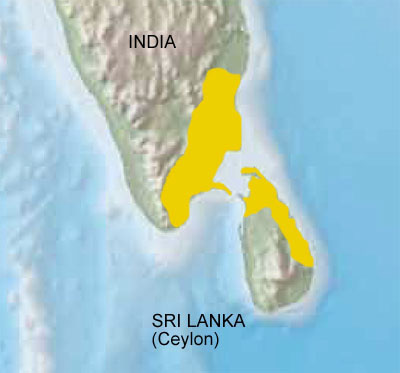Tamil Eelam |
|
|
|
| Übersicht – Contents: | |
Diese Seite ist Teil des Projektes
Tamil Eelam |
|
|
|
| Übersicht – Contents: | |
Flagge – Flag: |
|
 |
1983–2009, Flagge von Tamil Eelam – flag of Tamil Eelam, Quelle/Source, nach/by: Flags of the World |
| Die Flagge von Tamil Eelam zeigt eine stilisierte aufgehende gelbe Sonne mit neun Strahlen auf einem einfarbigen roten Untergrund. Die Farben Rot und Gelb scheinen für die Tamilen von großer Bedeutung zu sein, auch die Flagge der LTTE-Miliz zeigt diese Farben. | The flag of Tamil Eelam shows a stylized rising yellow sun with nine beams on a single-coloured red underground. It seems that the colours red and yellow have a special importance for the Tamils, even the flag of the LTTE-Militia shows that colours. |
| Quelle/Source: Volker Preuß | |
|
Landkarte der Siedlungsgebiete der Tamilen in Inden und Ceylon – Map of the areas of settlement of the Tamils in India and Ceylon |
 |
| Quelle/Source: Freeware, University of Texas Libraries, modyfied by: Volker Preuß |
| Zahlen und Fakten – Numbers and Facts: | |
|
|
|
|
|
|
|
|
| Der Konflikt zwischen Tamilen und Singhalesen auf der Insel Ceylon wird gerne auf die Tatasache reduziert, das die britische Kolonialmacht seit 1828 Tamilen als Lohnarbeiter auf Teeplantagen in Land holte. Der Staat Sri Lanka war nach seiner Unabhängigkeit nicht mehr bereit diese Tamilen zu dulden, und so wurden seit 1964 viele Tamilen zurück nach Indien umgesiedelt. Dagegen erbob sich Widerstand seitens der Tamilen, der ab 1983 in einen blutigen Bürgerkrieg mündete, der auf Seiten der Tamilen durch die LTTE-Miliz (Liberation Tigers of Tamil Eelam) gegen die Regierung Sri Lankas geführt wurde. Hauptforderung der Tamilen war die Schaffung eines unabhängigen, oder zumindest autonomen Staates Tamil Eelam im Norden und Osten der Insel. Der Bürgerkrieg durchlief mehrere Phasen, zunächst 1983 bis 1987, gipfelnd in einem Friedensabkommen zwischen der Regierung Sri Lankas und der Tamilischen LTTE-Miliz. Indische Truppen überwachten den Frieden, die 1988 von der LTTE-Miliz angegriffen wurden. 1990 haben die Indischen Truppen die Insel Ceylon verlassen. In einer zweiten Phase des Bürgerkriegs, von 1990 bis 1995, wurde Jaffna (die Hauptstadt der Tamilen) durch Regierungstruppen erobert. Eine dritte Phase, von 1996 bis 2009, die relativ ruhig verlief, gipfelte in einer plötzlichen Offensive der Regierungstruppen, die mit dem vollständigen militärischen Sieg der sri-lankischen Regierungstruppen über die LTTE-Miliz endete. Das war das Ende des bewaffneten Tamilischen Separatismus. Dieser ethnische Konflikt auf Ceylon wird der Kolonialmacht Großbritannien zu Unrecht angelastet, denn es wird übersehen, dass Tamilen seit dem 3. Jahrhundert vor Christus auf der Insel einwanderten, regelrechte Invasionen durchführten und eigene Königreiche auf der Insel gründeten, und zwar lange bevor der erste Europäer das Land betrat. Zu den ethnischen Unterschieden gesellen sich religiöse, denn Tamilen sind Hindus, im Gegensatz zu den buddhistischen Singhalesen. |
| Quelle/Source: Volker Preuß |
| It is convenient to reduce the conflict between Tamils and Singhalese on Ceylon Island the fact, that the British colonial power recruited Tamils as laborers on the tea plantations in the country since 1828. The state of Sri Lanka would no longer accept these Tamils after its independence, and they resettled many Tamils back to India since 1964. Against that arised resistance of the Tamils, which culminated in a bloody civil war since 1983. Here fight the LTTE Militia (Liberation Tigers of Tamil Eelam) on the side of the Tamils against the government of Sri Lanka. The main claim of the Tamils was the establishment of an independent, or at least autonomous State Tamil Eelam in the north and East of the island. The civil war went through several phases, initially from 1983 to 1987, culminating in a peace agreement between the Sri Lankan government and the Tamil LTTE militia. Indian troops monitored the peace and were attacked by the LTTE militia in 1988. In 1990, the Indian troops left the Island of Ceylon. In a second phase of the civil war, from 1990 to 1995, Jaffna (the Tamil capital) was captured by government troops. A third phase, from 1996 to 2009, which was relatively quiet, culminated in a sudden offensive by government forces, which ended with the complete military victory of the Sri Lankan government forces over the LTTE militia. That was the end of armed Tamil separatism. It is wrong to blame the colonial power of United Kingdom for this ethnic conflict on Ceylon, because they forget to see that Tamils immigrate on the island since the 3rd century B.C., made right invasions and established own kingdoms on the island, long times befor the first European set his foot on the island. The ethnic differences are added by religious, because Tamils are Hindus in contrast to the buddhist Singhalese. |
| Quelle/Source: Volker Preuß |